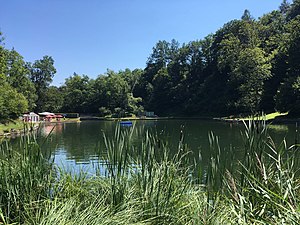Laghetto (Astano)
| Laghetto | ||
|---|---|---|

|
||
| The Laghetto from the northwest | ||
| Geographical location | Canton of Ticino | |
| Tributaries | Lisora | |
| Drain | Lisora | |
| Location close to the shore | Astano | |
| Data | ||
| Coordinates | 705 956 / 96656 | |
|
|
||
| Altitude above sea level | 600 m above sea level M. | |
| surface | 0.6 ha | |
| length | 120 m | |
| width | 60 m | |
| scope | 339 m | |
| Maximum depth | 10 m | |

|
||
| View from the southeast | ||
The Laghetto is a pre-alpine lake in the municipality of Astano in the canton of Ticino in Switzerland .
geography
The lake is 600 m above sea level. M. in a terrace hollow , at the southwestern foot of Monte Rogoria , around 600 meters west of the village center of Astano. The state border with Italy is around 500 meters to the northwest. The Laghetto is comparatively small with a length of 120 meters, a width of 60 meters, an area of 6000 square meters and a maximum depth of 10 meters. He is from the Lisora flows through, which leads to the north into the lake and in the southeast him a contactor leaves again, with the lake level can be regulated. In addition, the lake is fed by groundwater and fractured water.
history
The Italian word "Laghetto" means "little lake" in German. Since the body of water was also referred to as “stagno” (Italian for “pond” or “pond”), it is assumed that today's community name “Astano” goes back to the Laghetto.
The lake was much more silted up in the first half of the 20th century and, with an area of around 2000 square meters and a depth of around two meters, is significantly smaller than it is today. The bottom of the lake consisted of a ten meter thick layer of mud. At the beginning of the 1930s, according to a project by the architect Giuseppe Amadò, the area was converted into a lido with changing rooms, showers, wall parapets and barriers for bathers. Many people who had become unemployed as a result of the global economic crisis also found temporary employment. The property was fenced in in the 1950s.
The most far-reaching changes to the shape of the lake took place in the second half of the 1960s, when it was first completely pumped out and then dredged. The ten-meter-deep layer of sludge removed in the process was used for the rehabilitation of the adjacent marshland. In the course of this work, the Lisora were above the mouth of culverts , the outflow regulated and built a bar and a toilet. In the 1980s, the Pro Loco company took over ownership of the Astano municipality.
In the years 2011-2012, the interventions of the 1960s were partly reversed by the Lisora in Cimavalle to its confluence with the Laghetto rehabilitated was. Since then, the exposed stream has flowed through the lawn in the north of the lake and can be crossed there via a small wooden bridge.
ecology
Originally the lake was populated with tench , eel , char , crayfish , frogs and pond clams. The ring snake and the Aesculapian snake occur on the shore . In 1910 around 1,000 trout and char were released for the first time . Since the lake is used for sport fishing, trout are periodically released to support the fish population.
Economical meaning
The Laghetto is classified by the Ticino tourism agency as “one of the most important tourist attractions in Malcantone ”. It is primarily used as a lido, for sport fishing and as an event location for parties and concerts. The Al Laghetto campsite is in the immediate vicinity .
Web links
- Lake Astano on the Ticino Tourism Agency website
- Laghetto di Astano on the Astano Municipality website
- Laghetto di Astano at www.schweizersee.ch
Individual evidence
- ↑ Geoserver of the Swiss Federal Administration ( information )
- ↑ a b c d Teodoro Amadò: Appunti su Astano. Part 2. In: Almanacco Malcantonese e Valle del Vedeggio. Edizioni Bernasconi, Agno 2003, pp. 81-82.
- ↑ a b Helmut Fritz Etter: The Malcantone. A contribution to the geography of the Sottoceneri. In: Geographica Helvetica. Volume 18, 1963 ( digitized version ), p. 137.
- ↑ Santino Trezzini: Cronistoria di Astano. Consiglio Parrocchiale Astano, Astano 2010, p. 108.
- ↑ Santino Trezzini: Cronistoria di Astano. Consiglio Parrocchiale Astano, Astano 2010, p. 109.
- ↑ “Stammtisch” broadcast on May 21, 2016 on Rete Uno .
- ↑ Riapertura e valorizzazione Riale Lisora (Astano) on the website of EcoControl SA. Retrieved April 22, 2018 (PDF; 406 KB)
- ↑ Riapertura e valorizzazione riale Lisora on the Alleanza Territorio e Biodiversità website. Retrieved April 22, 2018 (PDF; 626 KB)
- ↑ Santino Trezzini: Cronistoria di Astano. Consiglio Parrocchiale Astano, Astano 2010, p. 110.
- ↑ Lake Astano on the website of the Ticino tourism agency . Retrieved April 3, 2018.
- ↑ Website of the Al Laghetto Astano campsite. Retrieved April 3, 2018.
